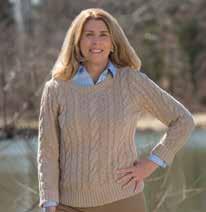
19 minute read
Editor’s Letter
Uncovering Disparities in the Age of COVID-19
COVID-19 has devastated communities across the nation and affected the lives of all, whether it be loss of work, constant exposure to a dismal news cycle, upheaval of routine due to ‘stay-at-home’ orders or direct association with the disease itself. Yet, research shows that some populations are more impacted than others, both by the disease itself (tinyurl. com/skkpc3z) and by the economic fallout (tinyurl.com/vqo3hbe). In addition to older adults and individuals with underlying health conditions, the people most at risk of being acutely affected include groups that face increased barriers in access to economic opportunities and healthcare — and preliminary data specific to COVID-19 shows that these people are disproportionately black and Latino (tinyurl.com/tguofln).
Advertisement
This imbalance of burden-bearing remains true for many of the issues the world faces today and will face in the coming months and years. One such example is climate change, which is a global concern, but the effects of which are disproportionately experienced by disadvantaged groups (tinyurl.com/su3asbg). In response to these disparities, Julian Agyeman, author and professor of Urban and Environmental Policy and Planning at Tufts University in Massachusetts, developed a concept about the “intentional integration of social justice and environmental sustainability,” called “just sustainabilities.” According to Agyeman, “…just sustainabilities was about acknowledging that we could probably legislate for a green planet, but if that planet [weren’t] also socially just, would it really be sustainable in the longer term?” In our cover feature beginning on page 36, titled “Julian Agyeman: A Visionary for Just Sustainabilities,” NRPA President and CEO Kristine Stratton speaks with Agyeman to discuss the concept of just sustainabilities and its application for parks and recreation.
Then, in “Collaboration in the Time of Pandemic” on page 42, contributor Paul Gilbert tells how a group of park directors from Northern Virginia are turning to each other for ideas and support, and to develop a unified message for their park users during the pandemic. “As a profession of highly adaptive and creative public servants, the park and recreation field is uniquely positioned to help our communities in the days ahead,” says Gilbert.
While COVID-19 has revealed some of the inequities our communities face, park and recreation professionals are working hard to provide lifesaving benefits to all people in all communities. Parks and recreation has always stood for inclusive spaces that provide health, wellness and quality of life for everyone. In these challenging times, the role of parks and recreation in promoting these values has been brought to the forefront, and professionals in the field are working in solidarity to address the current challenges. In future issues, we will explore further how park and recreation professionals are addressing this pandemic in their own community and agency.
Lastly, I would like to introduce our newest member of the NRPA team, Vitisia “Vi” Paynich as Parks & Recreation’s executive editor. Vi has been freelance writing for the magazine since 2016, and has extensive experience in print and digital publishing.
We here at NRPA thank you for all you are doing to make our world a healthier, safer place, and will continue to provide the support you need. For a list of our COVID-19 resources, visit nrpa.org/Coronavirus.
GINA MULLINS-COHEN Vice President of Communications and Chief Marketing Officer

PRESIDENT AND CEO
Kristine Stratton
VICE PRESIDENT OF COMMUNICATIONS AND CHIEF MARKETING OFFICER
Gina Mullins-Cohen gcohen@nrpa.org
EXECUTIVE EDITOR, PRINT AND ONLINE CONTENT
Vitisia Paynich vpaynich@nrpa.org
ASSOCIATE EDITOR
Lindsay Collins lcollins@nrpa.org
PUBLICATION DESIGN
Kim Mabon/Creative By Design CreativeByDesign.net
SENIOR SALES MANAGER EASTERN REGION AND EUROPE
Kip Ongstad 703.858.2174 kongstad@nrpa.org
SENIOR SALES MANAGER WESTERN REGION AND ASIA
Michelle Dellner 949.248.1057 mdellner@nrpa.org
SALES COORDINATOR
Meghan Fredriksen 703.858.2190 mfredriksen@nrpa.org
PHOTOGRAPHY Dreamstime.com or NRPA (unless otherwise noted)
MAGAZINE ADVISORY BOARD MEMBERS Anthony-Paul Diaz, Chair Michael Abbaté, FASLA Neelay Bhatt Ryan Eaker Beau Fieldsend Robert García Kathleen Gibi Paul Gilbert, CPRP Tim Herd, CPRE Brian Johnson, CPSI Denise Johnson-Caldwell Roslyn Johnson, CPRP Michele Lemons Sam Mendelsohn Maria Nardi Lisa Paradis, CPRP Paula Sliefert Shonnda Smith, CPRP, AFO Anne-Marie Spencer Stephen Springs
How can a school change a city forever?
It starts by thinking big. That’s exactly what happened when — through a partnership with the Energy Assist Foundation, the U.S. Soccer Foundation, and Musco Lighting — Santa Fe South High School in Oklahoma City installed an innovative soccer minipitch to benefit the local community.
Musco engineered an all-in-one Mini-Pitch System™ with LED lighting, fencing, goals, and ADA-compliant access to streamline construction. And in the end, Oklahoma City youth had a safer place to play, stay active, be mentored, and develop essential life skills.
Learn more about how the Mini-Pitch System transforms underused spaces at www.my-mini-pitch.com
©2020 Musco Sports Lighting, LLC · ADPR20-2
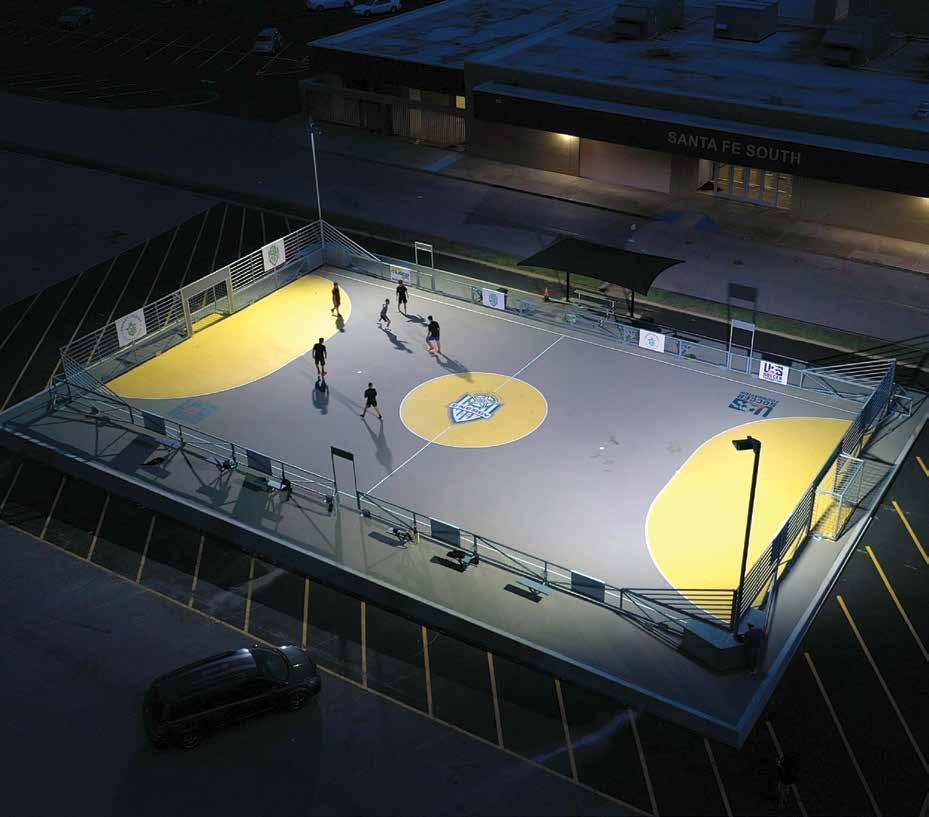
– Chris Brewster
Santa Fe South School District Superintendent
WE ARE PARKS & RECREATION
A Park Planner’s Perspective on the COVID-19 Pandemic
By Clement Lau, AICP, DPPD O n November 18, 2019, Woodcrest Play Park opened to the public. This innovative project transformed previously underutilized space at Woodcrest Library to a vibrant public park, and is the result of a collaboration between the Los Angeles County Library and the Los Angeles County Department of Parks and Recreation. The park consists of a children’s play area with book-themed elements, a seating area with USB and laptop charging stations, an outdoor fitness zone, and over 1,500 new drought-tolerant plants.
Park Need, Access and Benefits
Woodcrest Play Park is located in the unincorporated community of Westmont, which has about 33,000 residents and a very high level of park need per the 2016 Los Angeles Countywide Parks and Recreation Needs Assessment. This park has increased the percentage of Westmont residents living within a 10-minute walk of a park from 35 to 57 percent, which translates to an additional 7,000 residents, including 2,000 youth, being able to access a nearby park.
Sadly, a few months after its opening, the park closed due to the COVID-19 pandemic. While it is a necessary precaution, it is still disheartening to know the park and its wonderful amenities are not accessible to residents who need them most, even if it is temporary.
We all need parks. Not only was this the tag line for our needs assessment, but it is also a statement that has been validated repeatedly during the COVID-19 pandemic. At a time of need, our parks, beaches and trails revealed themselves as the essential
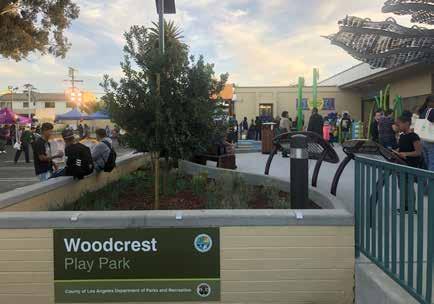
PHOTOS BY LOS ANGELES COUNTY DEPARTMENT OF PARKS AND RECREATION
civic infrastructure they are.
It is unfortunate that it took a pandemic for many to realize what park and recreation professionals have known and argued for a long time: we must invest in parks because they are critical to our quality of life and offer multiple vital benefits that are quantifiable (nrpa.org/HealthFactSheets).
Park Equity
The COVID-19 pandemic has put a spotlight on the park inequities that exist in L.A. and across the country. Our most underinvested communities are the ones most dependent on parks for their health and well-being. When failures to comply with physical distancing guidelines result in the closure of certain amenities and even entire parks and trails, lower-income residents suffer the most. As Catherine Nagel, executive director of City Parks Alliance, said in a recently released statement, “Parks and green infrastructure — especially in lowincome communities where their many benefits are often most needed — is often limited, leaving many residents without access to quality parks, recreational opportunities, and other positive environmental conditions. To help our communities recover, cities must invest equitably in parks and recreation facilities, redressing decades-long underinvestment.”
With the issuance of stay-at-home
Only a few months after its opening, Woodcrest Play Park was forced to close due to the COVID-19 pandemic.
Defining Epic Play
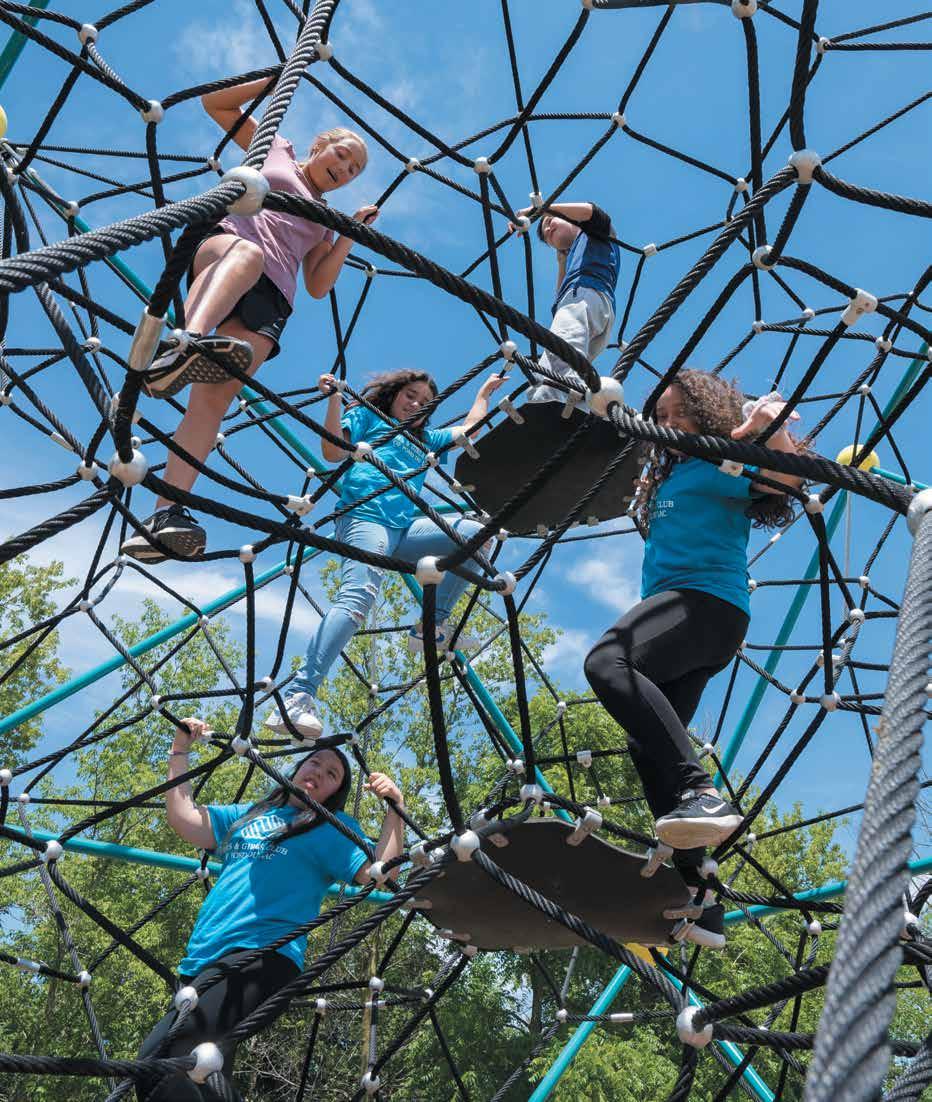
ep . ic adjective ep . ic | \‘e-pik\ a: extending beyond the usual or ordinary b: Heroic
Adventure. Development. Excitement. Fun. However you define it, we bring it.
It’s time to Join Our Movement.
bciburke.com
orders, we have been asked to stay home as much as possible, but are allowed to walk around our neighborhoods to get some fresh air or exercise. This makes sense because cabin fever is real and being inside for an extended period of time is challenging. However, not all neighborhoods are created equal. Specifically, lower-income residents often live in neighborhoods that have safety issues and/or lack the pedestrian infrastructure (like sidewalks, crosswalks, curb ramps and trees) and conditions that make walking safe and comfortable. In addition, while wealthier folks are likely to have sizable backyards, swimming pools and/or personal gyms, those living in underinvested communities do not have such luxuries.
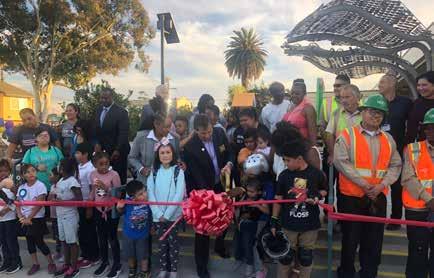
Ideas to Consider
A crisis like we’re experiencing is also an opportunity to reexamine current practices and contemplate new ideas. An important question that has emerged with the closure of many parks in L.A. is, “Can’t we find ways to manage recreation facilities without outlawing their use?” as Manal Aboelata, a parent and deputy executive director of Prevention Institute, asked in a letter to the editor.
Perhaps the concept of carrying capacity offers part of the answer. While the term is typically associated with national parks and is more concerned about the protection of these areas from overcrowding, I wonder if it could be adapted for local parks. Within the context of the COVID-19 pandemic, the goal would be to have some objective or scientific way, using GIS and other tools, to determine the capacity of a park, beach or trail, while considering physical distancing guidelines.
Another idea worth considering is the temporary conversion of some streets to public spaces where people can walk, exercise, bike and hang out without worrying about vehicular traffic. This is one of the recommendations that the National Association of City Transportation Officials has for cities as a way to create more space during COVID-19.
The Work Continues
So, what are L.A. County’s park planning and development professionals doing in the midst of the COVID-19 pandemic? Well, a few of my colleagues have been activated as disaster service workers on assignments, such
A ribbon-cutting ceremony for Woodcrest Play Park took place on November 18, 2019.
as providing GIS and administrative support at the L.A. County Office of Emergency Management and helping to staff a call center to assist small businesses. Some are working on efforts to temporarily convert indoor gyms at parks to emergency homeless shelters. The rest of us are continuing to do the necessary behind-the-scenes work to improve existing parks and develop new ones.
Stay Positive and Strong
For all my fellow park and recreation professionals, we must stay strong and continue to serve our communities to the best of our ability. There will be a day when the pandemic is over. There will be a day when our beloved beaches, trails and parks — like Woodcrest Play Park — will be re-opened. I look forward to that day.
For more information from the Los Angeles County Department of Parks and Recreation, please see the COVID-19 Updates from L.A. County Parks webpage (parks.la county.gov/covid-19).
For more information about NRPA’s response to COVID-19, as well as available resources for park and recreation professionals, please see our Coronavirus Disease 2019 (COVID-19) webpage (nrpa.org/ Coronavirus).
Editor’s Note: This article has been adapted from its original version posted to NRPA’s Open Space Blog (nrpa. org/Blog). To read the full text, visit nrpa.org/Covid19ParkPlanners.
Clement Lau, AICP, DPPD, is a Departmental Facilities Planner with the Los Angeles County Department of Parks and Recreation (clau@parks. lacounty.gov).
Military Solutions
Construction
Landscaping & Grounds Care
Golf & Sports Turf
Forestry
State, Local & Cooperative Contracts
Parts
Service
Support
Financing Golf & Sports Turf
Compact Construction Equipment
Front & Wide-Area Mowers
Tractors
Gator™ Utility Vehicles

Compact Utility Tractors
The perfect finish right from the start.
Out in the field or on the course, we’ve got you covered with the quiet, comfortable 1200A Field Rake – the go-to workhorse for sports turf pros everywhere. And back at the office? Thanks to contract pricing, wide selection and experienced local dealers, count on a process that makes getting the right equipment for the best price about as smooth as it could possibly be. JohnDeere.com/Local.

CAPRA Can Take an Agency from Good to Great
By Stacey Dicke, CPRP C ity of New Braunfels Parks and Recreation serves a city with a population of about 85,000. The department has 84 full-time employees, 110 part-time employees and an additional 180 seasonal staff. The city has a little more than 700 acres of parkland, one 18-hole golf course, one 74,000-square-foot recreation center, three outdoor pools and two historic cemeteries. The civic/convention center is also a part of the department.
I began my journey with NRPA’s Commission for Accreditation of Park and Recreation Agencies (CAPRA) in 2010 when I attended a CAPRA visitor training at the NRPA Annual Conference in Minneapolis. I left intrigued by the process and wondering if this would be something I would want to pursue back home.
My first visit to Grove City, Ohio, did not disappoint. The city’s parks and recreation director, Kim Conrad, and her crew were gracious hosts and gave me an incredible firsttime visitor experience. I worked with a team, led by parks and recreation director of St. Helena, California, Andre Pichly, that was patient,
City of New Braunfels Parks and Recreation initiated completion of all 151 CAPRA standards.
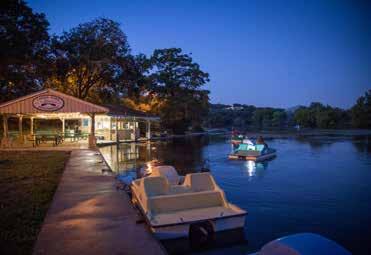
PHOTOGRAPH COURTESY OF CITY OF NEW BRAUNFELS
motivating and set me on the course for visitor success. I followed up that experience with visits for the next several years, even serving as a lead in Garner, North Carolina.
One of the things I loved best about serving on a visitation team was the amazing people I met. I have made not just professional contacts, but also lasting friendships. I loved taking a deep dive into some of the best agencies in the country, expanded my thought processes regarding agency makeup and protocols and brought home creative programs, ideas for innovative parks and facilities, and best practices for our profession.
I soon knew I wanted to pursue accreditation for my own department. I began by sharing my experiences with our staff when returning home from a visit. This insight of best practices began to pique curiosity within our staff. When our state association held a CAPRA training at our annual conference, I signed up all our staff to attend. This was a great way to have their questions answered and for them to talk with other agencies pursuing accreditation. It offered a chance to not only discuss the process, but also discover the reasons why these agencies were interested in CAPRA. It gave us a better understanding that the journey was not about checking another box or receiving acclamations, but rather about taking a department from good to great, and from doing our job well to defining and documenting our roles.
We started our journey by assessing each standard for compliance. This gave us a clear picture of the work ahead of us. We set an annual goal for each manager to complete a portion of the standards. This seemed like a comfortable way to allow staff to “dip their toes” in the waters of CAPRA. After two years of this practice, we initiated completion of all 151 standards. We organized a smartsheet to track our progress and gave regular updates on completion rates to the organization.
In April 2019, we were fortunate to bring a CAPRA training on-site and included all managers, supervisors and coordinators. We officially submitted our paperwork to NRPA in July 2019 and, at this writing, are scheduled for our site visit this upcoming June 2020. Due to a rapidly changing environment as a result of COVID-19, our visit will likely be different than we expected, but we are ready. We are proud of the work we have done, the improvements we have made and the course we have set for the future.
Stacey Dicke, CPRP, is Director of Parks and Recreation at City of New Braunfels, Texas (sdicke@nbtexas.org).
2020 Annual Conference Education Programming Overview
By John Prue
This year, NRPA received more than 700 education session topic submissions for the 2020 NRPA Annual Conference in Orlando, Florida, to be held October 27–29. Narrowing this record amount of proposals to around 185 sessions is the duty of the Conference Program Committee (CPC), a committee of dedicated volunteers representing the diversity of the park and recreation industry, working in a variety of capacities within their respective agencies. These volunteers sacrificed long hours over the December holidays and into the new year, reading and ranking each proposal for final selection discussions that took place at the winter meeting in Orlando on January 30 and 31.
Working hand-in-hand with NRPA staff, 12 topic subcommittees discussed the “best-of-the-best” in each category, attempting to provide an inclusive distribution of topics that covered a diversity of perspectives on the current challenges and opportunities that park and recreation professionals face. The open call for sessions delivered an abundance of proposals for Leadership & Management, Recreation & Sports Programming, Social Equity & Inclusion, and Planning, Design & Maintenance. The winter meeting allowed the CPC to convene and validate final selections, creating a distribution between 11 and 19 sessions within each of the 12 tracks and to note gaps in programming for the committee and NRPA to fill leading up to the main event.
The CPC and NRPA’s overall mission is always to select the best, most relevant education sessions to serve our peers and support NRPA’s Three Pillars. In addition, we also are working on future processes to continue to improve the way the CPC/NRPA determine what topics would be of most value to our colleagues, seeking out top speakers in the field, developing the diversity of the profession and ultimately improving how we sift through hundreds of session proposals in an intentional, mission-driven manner.
The winter meeting was also an opportunity for the CPC to experience the host city, guided by the generosity of Marcia Bowen, CPRP, from the city of Orlando. Marcia’s programmed tours of the city parks, meetings with elected officials and shared information regarding the city of Orlando helped to inform the topics that were finally selected to align with the 2020 NRPA Annual Conference setting and suggested off-site institutes.
By the time we all arrive in Orlando, we will have spent the better part of the year setting up educational sessions to be offered at this year’s conference. This is my seventh year on the committee and as the chairperson for this year, I’ve never been prouder of the work we have done and of my fellow members on the CPC.
John Prue is Installation Program Director at Morale, Welfare and Recreation, Naval Station Great Lakes, Illinois, and the 2020 NRPA Annual Conference Program Committee Chair (john.prue@navy.mil).
LSPR Honors Tom Lovell with Community Center Dedication
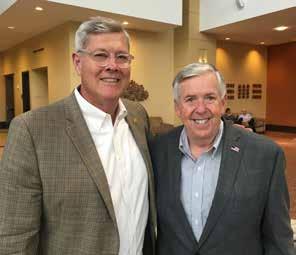
On September 12, 2019, Lee’s Summit Parks and Recreation (LSPR) in Lee’s Summit, Missouri, renamed and dedicated its principal community center in honor of the department’s former administrator, Tom Lovell. What was previously the Legacy Park Community Center is now the J. Thomas Lovell Jr. Community Center at Legacy Park.
“Tom Lovell was the driving force behind the successes and accomplishments of LSPR for 38 years,” says Joe Snook, current LSPR administrator, in a press release (tinyurl.com/ ujwuapc). “I cannot think of a more appropriate way to honor his legacy than to name our flagship community center after Mr. Lovell.”
During Lovell’s service as administrator of LSPR from 1979 to 2017, the department grew from 12 staff members to 42 full-time employees and hundreds PHOTOGRAPH COURTESY OF TOM LOVELL of part-time and seasonal employees. Under Lovell’s leadership, LSPR acquired more than 950 acres of new open space and developed 77 miles of trails, 30 neighborhood parks, three Tom Lovell (left) poses for a picture with community centers Missouri Governor Mike Parson. and a water park. In addition, LSPR earned CAPRA accreditation in 2003 and became reaccredited in 2008 and 2013. In 2010, the department was awarded the American Academy for Park and Recreation Administration’s National Gold Medal Award.
“This is such a surprise and special honor to have this flagship facility renamed after me,” says Lovell. “[Legacy Park Community Center] has served the community and has substantiated the beliefs in the parks system to provide services, benefits to our health and generate revenue for Lee’s Summit. I am humbled and would like to thank all the people involved in the development of the facility and those renaming [it].”
Member Benefit: NRPA Career Center Resources
Whether you are a job seeker or an employer who is looking to hire qualified individuals, the NRPA Career Center is here to help during this difficult time.

Job Seeker Resources: • Choosing a Career in Parks
and Recreation – Visit our page that highlights different professions throughout the field and also takes a look at 10 typical park and recreation agency position salaries. • Job Alerts – Once you select your search criteria and submit a search, you will have the option to set up a Job Alert to receive emails daily with matching jobs. • Upload Your Résumé – Post your résumé for employers to find and contact you.
Employer Resources:
• Google for Jobs Integration – Jobs posted to the NRPA Career Center are automatically searchable through Google for Jobs, creating even greater exposure. The Google for Jobs application appears before Google’s standard search results, prioritizing your positions. • Easily Manage Your Applications – After your job listing is posted, it then becomes time to manage all the applications you’ve received. Stay organized by marking candidates you are interested in and deleting applicants who don’t fit the position. • Job Posting Tips & Sample Descriptions – The Career
Center offers employer resources to help your job posts stand out and attract top candidates. It also includes a summary of best practices for posting jobs online following government compliance.
The NRPA Career Center is the best online resource for reaching qualified park and recreation professionals. Not only can you post or browse current job opportunities from around the country, but there are also internship and seasonal positions. NRPA members can post both internship and seasonal opportunities for free. Visit nrpa.org/Careers to see all the resources available.










